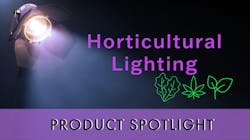Product Spotlight: Horticultural Lighting (MAGAZINE)
Horticulture applications represent an incredible market opportunity for LED suppliers and solid-state lighting manufacturers. Whether used in supplemental lighting for greenhouses or controlled environment agriculture (CEA) operations such as indoor or vertical farms, LEDs' controllability, customizability of spectral content, and flexible form factor can help to improve yields and enhance desirable features of many cultivars.
Alina luminaire and power system, RAYN Growing Systems
Alina LED luminaires feature six individually controllable color channels: white, blue, lime, green, deep red, and far red. Two optional wavebands can host more existing colors or include ultraviolet, far red, or other wavelengths. Fixtures dim smoothly across each waveband from 0% to 100%, according to RAYN. The power system is available in 350W, 600W, and 1500W versions to support horticultural research installations of varying sizes. Multiple modular luminaires can be ganged together and mounted within shelving systems or suspended with wires from the CEA structure.
Verjure, Acuity Brands
Three sizes and output levels of Verjure horticultural fixtures support plant growth from vegetative to flowering stages. Full-spectrum LEDs with a higher concentration of red wavelengths produce up to 27% higher flower yield per dollar in electricity costs, according to Acuity. Verjure fixtures deliver up to 1880 μmol/s at 2.8-μmol/J efficacy, reducing energy consumption up to 40% compared to 1000W high-pressure sodium (HPS) grow lights. Optional wireless nLight AIR controls assist with setup and zone configuration. Tool-less, foldable design and removable lenses simplify installation and maintenance.
Arize Element L1000 and L2000, Current
The Arize Element Next-Generation L1000 and L2000 toplights bring 2.6-μmol/J and 3.600-μmol/J efficacy to Current’s Element lineup, respectively. Proprietary XW Optics achieve uniform light distribution across a wide area from a slim fixture housing that reduces crop shading and enables growers to install fewer fixtures. Eight spectral options include dual-band purple and broad-spectrum white, among others. Dimming from 0–10V is standard. Mounting options, including unistrut, offset, square brackets, and universal cable, offering flexible configurations.
MegaDrive Vertical Series, California Lightworks
These LED luminaires are designed to replace HPS sources in single-level indoor grow facilities or on shelves in multilevel configurations. Up to 27 lightweight luminaires can be chained to one power unit, reducing power equipment installation over the canopy and lessening heat output from power electronics. Programmable dual-channel spectrum control, passive cooling, and efficacy up to 3.5 µmol/J illuminate all stages from vegetative through flowering and finishing stages.
Aelius 880, Aelius LED
The Aelius 880 luminaire addresses high-bay configuration in large-scale commercial grows. The 4-ft2 output area matches common table dimensions, wasting fewer photons and thereby utilizing energy more efficiently. A copper pipe design for cooling reduces fixture weight to less than 30 lb. Four light recipes target cannabis flower and larger fruiting crops, craft cannabis, supplemental greenhouse, and various cultivars that respond to full-spectrum light. Luminaires are CE, cETLus, and DLC certified.
AB Series, AB Lighting
AB Lighting released several AB Series grow lights for cannabis cultivation. The AB840 (840W input power) is a 1:1 replacement for HPS, with PPF of 2100 µmol/s for indoor cultivation or as greenhouse supplemental lighting. The AB780 (780W), with PPF of 2067 µmol/s, is designed for indoor cultivation. The AB960 (960W), a high-intensity toplight for indoor cultivation, delivers PPF of 2400 µmol/s. The newest AB520 (520W) toplight is designed to support early vegetation with tuned spectra and 1,200–1,300 µmol/s PPF. All AB Series lights are 0–10V dimmable and have shown lifetimes over 50,000 hours.
TriPlane, P.L. Light Systems
The luminaire’s LED modules can be independently field adjusted for specific light distribution needs. A 1:1 replacement for 1000W high-intensity discharge (HID) luminaires, TriPlane lowers HVAC loads and heat stress on plants by optimizing its thermal management. An aluminum enclosure allows airflow around the integrated driver, and thermal fins on top of the LED modules dissipate heat. A standard horticultural power connector and simplified mounting brackets support plug-and-play retrofitting of existing HID lighting.
For more products and industry news, visit ledsmagazine.com/company-newsfeed.
CARRIE MEADOWS is managing editor of LEDs Magazine, with 20+ years’ experience in business-to-business publishing across technology markets including solid-state technology manufacturing, fiberoptic communications, machine vision, lasers and photonics, and LEDs and lighting.
For up-to-the-minute LED and SSL updates, why not follow us on Twitter? You’ll find curated content and commentary, as well as information on industry events, webcasts, and surveys on our LinkedIn Company Page and Facebook page.

Carrie Meadows | Editor-in-Chief, LEDs Magazine
Carrie Meadows has more than 20 years of experience in the publishing and media industry. She worked with the PennWell Technology Group for more than 17 years, having been part of the editorial staff at Solid State Technology, Microlithography World, Lightwave, Portable Design, CleanRooms, Laser Focus World, and Vision Systems Design before the group was acquired by current parent company Endeavor Business Media.
Meadows has received finalist recognition for LEDs Magazine in the FOLIO Eddie Awards, and has volunteered as a judge on several B2B editorial awards committees. She received a BA in English literature from Saint Anselm College, and earned thesis honors in the college's Geisel Library. Without the patience to sit down and write a book of her own, she has gladly undertaken the role of editor for the writings of friends and family.
Meadows enjoys living in the beautiful but sometimes unpredictable four seasons of the New England region, volunteering with an animal shelter, reading (of course), and walking with friends and extended "dog family" in her spare time.












